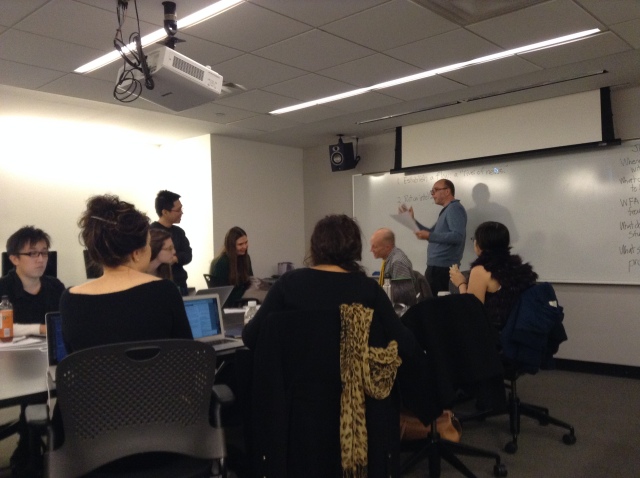 Just footsteps from the New York Times in midtown Manhattan, is the easy-to-miss doorway of the City University of New York. Only eight years old, CUNY has a somewhat small, but progressive journalism school with just 100 students.
Just footsteps from the New York Times in midtown Manhattan, is the easy-to-miss doorway of the City University of New York. Only eight years old, CUNY has a somewhat small, but progressive journalism school with just 100 students.
“I’ve been teaching this from the beginning,” said Jeff Jarvis, the entrepreneurial journalism professor and author.
“I was brought in to be the interactive, crazy guy.”
CUNY sees itself as a leader in the emerging field of entrepreneurial journalism. In 2010, CUNY’s Tow-Knight Centre for Entrepreneurial Journalism was founded thanks to Knight Foundation grants. And it teaches big “E” entrepreneurialism.
“I insist students must do for-profit businesses,” said Jarvis. “They need to understand how to make journalism sustainable…and we teach ethics early in the term.”
In an earlier post about MIT’s Centre for Civic Media I talked about Ethan Zuckerman’s discomfort with entrepreneurial journalism and his preference for the non-profit type. Zuckerman and Jarvis know each other, and I’m sure have lively debates.
So what Jarvis and his colleagues, including Jeremy Caplan, encourage is the actual development and creation of start-ups as course projects. Each of the 15 students comes up with a business plan. Some of these projects make it beyond the classroom, some don’t. Then there are CUNY graduates who take their innovative ideas and made them work inside a mainstream media organization. (Some call this intrapreneurialism.)
“The goal is to make them more literate in business. And past graduation there’s mentoring.”
On my morning at CUNY, I sit in on Caplan and Jarvis’s class. They’re practicing their elevator pitches. All the students have been developing projects since September. Now each needs to be able to explain it in 4 minutes – they must clearly, concisely sell their plan.

Click photo to see the journalism Class at CUNY
The first few are pretty clunky. Jarvis points out their weaknesses including “up-talking, verbal ticks and lack of eye-contact.” But the main point these profs are pushing is the clear delivery of their key message – one that must be ready to present to potential investors and consumers by the next class.
“You need to sell it,” Jarvis said to the students. “I’m a reader, or an investor, you need to convince me this is a viable business. And you need to anticipate my questions.”
Over the past 10 weeks, these budding entrepreneurs have been taught that their businesses must be based on a solution to a problem. Many of the solutions in the room involve creating a niche website for a particular community in New York.
One is a news forum dedicated to “queer” news (both curated and original) in NYC. Another student is developing a site for artists in the Bronx to advertise what’s being ignored in that part of the city. A South-Asian arts magazine is the last pitch I hear. It’s already up and running, has advertisers and allows readers to buy stuff on-line.
The course pushes the students to research potential business models, audience and competition. They need to develop a budget with expected costs and cash flow. They build charts to show their enterprise’s hopeful revenue trajectory.
To close this day’s class, Jarvis welcomes in a guest – a former student who has made good. Annaliese Griffin is Editor-in-Chief of Brooklyn Based. “The best source for events, food and cultural news in the borough.”
Brooklyn Based has a web presence and produces an email newsletter to keep subscribers up to date with events, people and places in Brooklyn. It makes money through events and advertising. It’s a good example of what can be accomplished. But Griffin gives the students a reality check. Nurturing a fledgling business means hard work, little sleep, a lot of hustle and tough decisions.
CUNY doesn’t sugar coat the business of journalism. But it does provide skills that will help reporters and editors whether they work within a traditional organization or create their own. It may be “for profit”, but that doesn’t necessarily mean making a whole lot of money. It does mean making journalism, creating a buzz. Like any kind of entrepreneurialism it means trying, failing and trying again.






 Lisa Williams says she’s a fairy godmother for investigative journalists.
Lisa Williams says she’s a fairy godmother for investigative journalists.
 It was difficult not to make my first question to
It was difficult not to make my first question to 


 My recent conversation with
My recent conversation with 